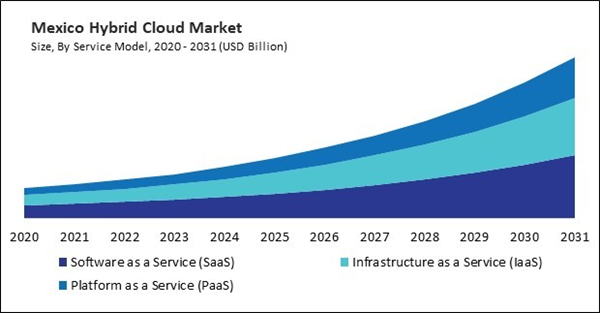The US market dominated the North America Hybrid Cloud Market by Country in 2023, and would continue to be a dominant market till 2031; thereby, achieving a market value of $81.13 billion by 2031. The Canada market is experiencing a CAGR of 18.5% during (2024 - 2031). Additionally, the Mexico market would exhibit a CAGR of 17.6% during (2024 - 2031).
A hybrid cloud enables organizations to implement geo-redundant backup solutions that replicate data across multiple locations. This approach ensures data availability and integrity in regional disasters or outages.
Additionally, Organizations can use cloud resources for on-demand failover during disasters, allowing them to switch operations to cloud-based systems while recovering on-premises infrastructure quickly. Also, the hybrid cloud provides robust disaster recovery solutions by enabling data backup and failover capabilities across multiple environments.
Rising internet penetration in Mexico leads to more businesses in the country adopting hybrid cloud solutions. Improved connectivity facilitates the use of cloud services, allowing Mexican companies to integrate on-premises infrastructure with public and private clouds seamlessly. According to the International Trade Administration (ITA), Mexico’s telecommunications sector has consistently exceeded the overall economic growth, primarily due to advancements in mobile phones, broadband services, and broadcasting.
Based on Component, the market is segmented into Solution and Services. Based on Enterprise Size, the market is segmented into Small & Medium-sized Enterprises and Large Enterprises. Based on Service Model, the market is segmented into Software as a Service (SaaS), Infrastructure as a Service (IaaS), and Platform as a Service (PaaS). Based on Industry Vertical, the market is segmented into BFSI, IT & Telecom, Healthcare, Retail, Government, Media & Entertainment, Transportation & Logistics, Manufacturing, and Others. Based on countries, the market is segmented into U.S., Mexico, Canada, and Rest of North America.
List of Key Companies Profiled
- Amazon Web Services, Inc. (Amazon.com, Inc.)
- Microsoft Corporation
- Google LLC
- IBM Corporation
- Oracle Corporation
- SAP SE
- Salesforce, Inc.
- Dell Technologies, Inc.
- Equinix, Inc.
- Nutanix, Inc.
Market Report Segmentation
By Component
- Solution
- Services
By Enterprise Size
- Small & Medium-sized Enterprises
- Large Enterprises
By Service Model
- Software as a Service (SaaS)
- Infrastructure as a Service (IaaS)
- Platform as a Service (PaaS)
By Industry Vertical
- BFSI
- IT & Telecom
- Healthcare
- Retail
- Government
- Media & Entertainment
- Transportation & Logistics
- Manufacturing
- Others
By Country
- US
- Canada
- Mexico
- Rest of North America
Table of Contents
Companies Mentioned
- Amazon Web Services, Inc. (Amazon.com, Inc.)
- Microsoft Corporation
- Google LLC
- IBM Corporation
- Oracle Corporation
- SAP SE
- Salesforce, Inc.
- Dell Technologies, Inc.
- Equinix, Inc.
- Nutanix, Inc.
Methodology

LOADING...









